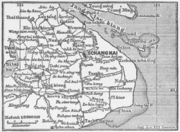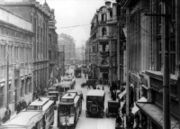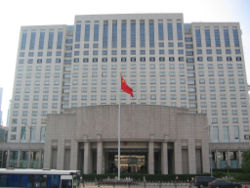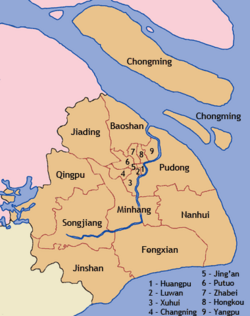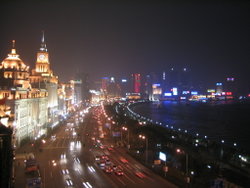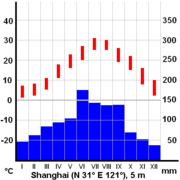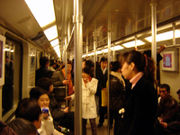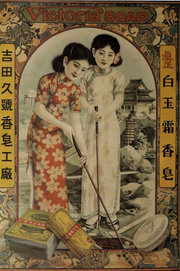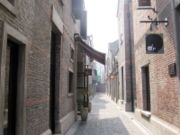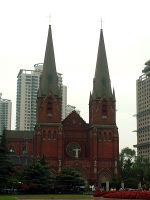Shanghai
2007 Schools Wikipedia Selection. Related subjects: Geography of Asia
| Shanghai (上海) | |
|---|---|
 |
|
| Location in the People's Republic of China | |
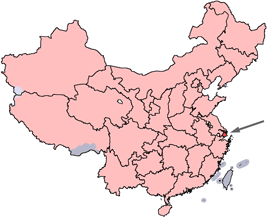
|
|
| Basic Information | |
| Origin of name: | 上 shàng - on/above 海 hǎi - sea 市 shì - city "City on the Sea" |
| Abbreviation: | 沪 Hù and 申 Shēn |
| Area: | 6,340.5 km² ( 31st) |
| Population ( 2005): | 17,780,000 ( 25th) Municipality |
| 9,838,000 Urban Area, 2001 est. | |
| Density ( 2005): | 2804/km² ( 1st) Municipality |
| GDP ( 2004): - per capita |
CNY 745.0 billion ( 7th) CNY 42,800 ( 1st) |
| HDI ( 2005) | 0.909 ( 1st) — high |
| Major nationalities ( 2000): | Han - 99% Hui - 0.4% |
| City flower: | Yulan magnolia (Magnolia denudata) |
| Elevation: | 0 - 103.4 m |
| Coordinates: | |
| Postal code: | 200000 - 202100 |
| Area code: | +86/21 |
| License plate prefixes : | 沪A, B, D, E |
| 沪C (outer suburbs) | |
| ISO 3166-2: | cn-31 |
| Time zone : | UTC+8 |
| Website : | www.shanghai.gov.cn |
| Government | |
| Administration Type: | Municipality |
| CPC Shanghai Committee Secretary: |
Han Zheng (acting) |
| Mayor: | Han Zheng |
| County-level divisions: | 18 Districts and 1 County |
| Township-level divisions: | 220 Towns and Villages |
Shanghai (Chinese: 上海; pinyin: Shànghǎi ; Shanghainese: /zɑ̃'he/), situated on the banks of the Yangtze River Delta in East China, is the largest city of the People's Republic of China and the eighth largest in the world. Widely regarded as the citadel of China's modern economy, the city also serves as one of the most important cultural, commercial, financial, industrial and communications centers of China. Administratively, Shanghai is a municipality of the People's Republic of China that has province-level status. Shanghai is also one of the world's busiest ports, and became the largest cargo port in the world in 2005.
Originally a sleepy fishing town, Shanghai became China's most important city by the 20th century and was the centre of popular culture, vice, intellectual discourse and political intrigue during the Republic of China. Shanghai once became the third largest financial centre in the world, ranking after New York City and London, and the largest commercial city in the Far East in the late 19th century and early 20th century. After the communist takeover in 1949, Shanghai languished under heavy central government taxation and much of its bourgeois elements were purged. Following the central government's authorization of market-economic redevelopment of Shanghai in 1992, Shanghai quickly surpassed early-starters Shenzhen and Guangzhou, and has since led China's economic growth. Some challenges remain for Shanghai at the beginning of the 21st century, as the city struggles to cope with increased worker migration, and a huge wealth gap. However, these challenges aside, Shanghai's skyscrapers and modern lifestyle mark the pinnacle of China's recent economic development.
Origin of name
The two Chinese characters in the name "Shanghai" (see left) literally mean "on"/"top" and "sea". The local Shanghainese pronunciation of Shanghai is /zɑ̃.'he/, while the Standard Mandarin pronunciation in Hanyu Pinyin is Shànghǎi. The earliest occurrence of this name dates from the Song Dynasty (11th century), at which time there was already a river confluence and a town with this name in the area. There are disputes as to how the name should be interpreted, but official local histories have consistently said that it means "the upper reaches of the sea" (海之上洋). However, another reading, especially in Mandarin, also suggests the sense of "go onto the sea," which is consistent with the seaport status of the city. The more poetic name for Shanghai switches the order of the two characters, i.e., Haishang (海上), and is often used for terms related to Shanghainese art and culture. In the West, Shanghai has also been spelled Schanghai (in German), Sjanghai (in Dutch), Xangai (in Portuguese) and Changhaï (in French), but since the 1990s the Hanyu Pinyin spelling of "Shanghai" has become universal in the West. In Japanese, Shanghai is written using the same two Chinese characters (上海), and the Japanese pronunciation Shanhai (シャンハイ) is an approximate of the Mandarin pronunciation.
Shanghai's abbreviations in Chinese are Hù (沪) and Shēn (申). The former is derived from the ancient name Hu Du (沪渎) of the river now known as Suzhou Creek. The latter is derived from the name of Chunshen Jun (春申君), a nobleman of the Chu Kingdom (楚国) in the 3rd century B.C. whose territory included the Shanghai area and has locally been revered as a hero. Sports teams and newspapers in Shanghai often use the character Shēn (申) in their names. Shanghai is also commonly called Shēnchéng (申城, "City of Shēn").
The city has had various nicknames in English, including "Paris of the East", "Queen of the Orient", "Pearl of the Orient", and even "The Whore of Asia" (a reference to widespread corruption of vice, drugs, and prostitution in the 1920s and 1930s).
History
Pre-19th century
Before the formation of Shanghai city, Shanghai was part of Songjiang county (松江縣), governed by Suzhou prefecture (蘇州府). From the time of the Song Dynasty (960-1279), Shanghai gradually became a busy seaport, outgrowing its original political jurisdictions. For instance, Songjiang (淞江) today is one of 18 districts within Shanghai.
A city wall was built in AD 1553, which is generally accepted as the start of the city of Shanghai. However, before the 19th century, Shanghai was not considered a major city of China. Therefore, compared to most other major Chinese cities today, there are few ancient Chinese landmarks to be found in the city. The few cultural landmarks to be found are very ancient and typically date to the Three Kingdoms period of Chinese history. This is mostly due to the fact that present-day Shanghai is within the historic cultural centre of the Wu Kingdom (222-280).
During the Qianlong era of the Qing Dynasty, Shanghai became an important regional port for the Yangtze and Huangpu rivers. It also became a major seaport for the nearby Jiangsu and Zhejiang provinces, although overseas commerce was still forbidden at that time. A historically important area of this era is Wujiaochang (五角场) (now in the Yangpu District), the foundation of the city centre. Around the end of the Qianlong era, Shiliupu (十六铺) (now in the Huangpu District) became the largest port in East Asia.
19th to early 20th century
The importance of Shanghai grew radically in the 19th century, as the city's strategic position at the mouth of the Yangtze River made it an ideal location for trade with the West.
During the First Opium War in the early-19th century, British forces temporarily held Shanghai. The war ended with the 1842 Treaty of Nanjing, which saw the treaty ports, Shanghai included, opened for international trade. The Treaty of the Bogue signed in 1843, and the Sino-American Treaty of Wangsia signed in 1844 together saw foreign nations achieve extraterritoriality on Chinese soil, which officially lasted until 1943 but was essentially defunct by the late 1930s. From the twenties to the late 30s Shanghai was a so-called ' sin city'. Gangsters wielded a great deal of power and ran casinos and brothels.
The Taiping Rebellion broke out in 1850, and in 1853 Shanghai was occupied by a triad offshoot of the rebels, called the Small Swords Society. The fighting destroyed the countryside but left the foreigners' settlements untouched, and Chinese arrived seeking refuge. Although previously Chinese were forbidden to live in foreign settlements, 1854 saw new regulations drawn up making land available to Chinese. Land prices rose substantially.
1854 also saw the first annual meeting of the Shanghai Municipal Council, created in order to manage the foreign settlements. In 1863, the British settlement, located along the western bank of the Huangpu river to the south of Suzhou creek (Huangpu district), and American settlement, located on the western bank of the Huangpu river and to the north of Suzhou creek (Hankou district) joined in order to form the International Settlement. The French opted out of the Shanghai Municipal Council, and instead maintained its own French Concession, located to the west of the International Settlement. This period saw a large influx of migrants from Europe and North America, who called themselves " Shanghighlanders".
The Sino-Japanese War fought 1894- 95 over control of Korea concluded with the Treaty of Shimonoseki, which saw Japan emerge as an additional foreign power in Shanghai. Japan built the first factories in Shanghai, which were soon copied by other foreign powers to effect the emergence of Shanghai industry. Shanghai was then the biggest financial city in the Far East. Under the Republic of China, Shanghai was made a special city in 1927, and a municipality in May 1930. The Japanese Navy bombed Shanghai on January 28, 1932, nominally in an effort to crush down Chinese student protests of the Manchurian Incident and the subsequent Japanese occupation. The Chinese fought back in what was known as the January 28 Incident. The two sides fought to a standstill and a ceasefire was brokered in May. In the Second Sino-Japanese War, the city fell after the Battle of Shanghai in 1937, and was occupied until Japan's surrender in 1945. The International Settlement was occupied on 8 December 1941 with opposition from only the one remaining British gunboat stationed in the port and some Chinese irregulars.
During World War II
Shanghai had been a centre for refugees as early as 1919 when large numbers of White Russians fleeing revolution and civil war took up residence there. Russians comprised the second largest foreign community in Shanghai (after the Japanese) and played a important role in the economy and policing of the International Settlement until the end of World War II.
During World War II, Shanghai became again a centre for refugees from Europe. It was the only city in the world that was open unconditionally to the Jews at the time. As a result, approximately 32,000 Jews, who like the other foreign communities termed themselves "Shanghailanders," settled in this fascinating Chinese city. However, under pressure from their Nazi allies, the Japanese ghettoised the Jewish refugees in late 1941 in what came to be known as the Shanghai ghetto, and hunger and infectious diseases such as amoebic dysentery became rife. Nevertheless, the Japanese government refused Nazi requests to deport the Jewish population.
Communist rule
On May 27, 1949, Shanghai came under communist control and was one of the only two former Republic of China (ROC) municipalities not merged into neighbouring provinces over the next decade (the other being Beijing). It underwent a series of changes in the boundaries of its subdivisions, especially in the next decade.
After the communist takeover in 1949, most foreign firms moved their offices from Shanghai to Hong Kong. During the 1950s and 1960s, Shanghai became an industrial center and centre for revolutionary leftism. Yet, even during the most tumultuous times of the Cultural Revolution, Shanghai was able to maintain high economic productivity and relative social stability. In most of the history of the People's Republic of China (PRC), Shanghai has been the largest contributor of tax revenue to the central government compared with other Chinese provinces and municipalities. This came at the cost of severely crippling Shanghai's infrastructure and capital development. Its importance to China's fiscal well-being also denied it economic liberalizations that were started in the far southern provinces such as Guangdong during the mid-1980s. At that time Guangdong province paid nearly no taxes to the central government, and thus was perceived as fiscally expendable for experimental economic reforms. Shanghai was not permitted to initiate economic reforms until 1991.
Political power in Shanghai has traditionally been seen as a stepping stone to higher positions within the PRC central government. In the 1990s, there was what was often described as the politically right-of-centre " Shanghai clique," which included the president of the PRC Jiang Zemin and the premier of the PRC Zhu Rongji. Starting in 1992, the central government under Jiang Zemin, a former Mayor of Shanghai, began reducing the tax burden on Shanghai and encouraging both foreign and domestic investment in order to promote it as the economic hub of East Asia and to encourage its role as gateway of investment to the Chinese interior. Since then it has experienced continuous economic growth of between 9–15% annually.
Politics and Administration
Politics
Shanghai has been a political hub of China for many years. Many of China's top government officials in Beijing are known to have risen in Shanghai in the 1980s on a platform that was critical of the extreme leftism of the Cultural Revolution, giving them the tag " Shanghai Clique" during the 1990s. Many observers of Chinese politics view the more right-leaning Shanghai Clique as an opposing and competing faction of the current Chinese administration under President Hu Jintao and Premier Wen Jiabao. Shanghai's top jobs, the Party Chief and the position of Mayor, have always been prominent on a national scale. Four Shanghai mayors eventually went on to take prominent Central Government positions, including former President Jiang Zemin and former Premier Zhu Rongji. The top administrative jobs are always appointed directly by the Central Government.
The current Shanghai government under Mayor Han Zheng has openly advocated transparency in the city's government. However, in previous years a complicated system of relationships between Shanghai's government, banks, and other civil institutions has been under scrutiny for corruption, motivated by faction politics in Beijing; these allegations from Beijing did not go anywhere until late 2006.
In September 2006, the Shanghai Communist Party Chair Chen Liangyu and a number of his followers were removed from their positions after a probe into the city's pension fund. Over a hundred investigators, sent by the Central Government, reportedly uncovered clues of money diversion from the city's pension fund to unapproved loans and investments. Chen Liangyu, a member of former President Jiang Zemin's Shanghai Clique, was seen as a major rival of President Hu Jintao and Premier Wen Jiabao. Chen's abrupt removal is viewed by many Chinese as a political maneuver by Hu Jintao to further secure his power in the country. See the article on Chen Liangyu for more information regarding his dismissal.
Subdivisions
Shanghai is administratively equal to a province and is divided into 19 county-level divisions: 18 districts and 1 county. There is no single downtown district in Shanghai, the urban core is scattered across several districts. Prominent central business areas include Lujiazui on the east bank of the Huangpu River, and The Bund and Hongqiao areas in the west bank of the Huangpu River. The city hall and major administration units are located in Huangpu District, which also serve as a commercial area, including the famous Nanjing Road. Other major commercial areas include the classy Xintiandi and Huaihai Road in Luwan district and Xujiahui in Xuhui District. Many universities in Shanghai are located in residential areas of Yangpu District and Putuo District.
Nine of the districts govern Puxi (literally West Bank), or the older part of urban Shanghai on the west bank of the Huangpu River. These nine districts are collectively referred to as Shanghai Proper (上海市区) or the core city (市中心):
- Huangpu District ( Simplified Chinese: 黄浦区; pinyin: Huángpǔ Qū)
- Luwan District (卢湾区 Lúwān Qū)
- Xuhui District (徐汇区 Xúhuì Qū)
- Changning District (长宁区 Chángníng Qū)
- Jing'an District (静安区 Jìng'ān Qū)
- Putuo District (普陀区 Pǔtuó Qū)
- Zhabei District (闸北区 Zháběi Qū)
- Hongkou District (虹口区 Hóngkǒu Qū)
- Yangpu District (杨浦区 Yángpǔ Qū)
Pudong (East Bank), or the newer part of urban and suburban Shanghai on the east bank of the Huangpu River, is governed by:
- Pudong New District (浦东新区 Pǔdōng Xīn Qū) — Chuansha County until 1992
Eight of the districts govern suburbs, satellite towns, and rural areas further away from the urban core:
- Baoshan District (宝山区 Bǎoshān Qū) — Baoshan County until 1988
- Minhang District (闵行区 Mǐnháng Qū) — Shanghai County until 1992
- Jiading District (嘉定区 Jiādìng Qū) — Jiading County until 1992
- Jinshan District (金山区 Jīnshān Qū) — Jinshan County until 1997
- Songjiang District (松江区 Sōngjiāng Qū) — Songjiang County until 1998
- Qingpu District (青浦区 Qīngpǔ Qū) — Qingpu County until 1999
- Nanhui District (南汇区 Nánhuì Qū) — Nanhui County until 2001
- Fengxian District (奉贤区 Fèngxián Qū) — Fengxian County until 2001
Chongming Island, an island at the mouth of the Yangtze, is governed by:
- Chongming County (崇明县 Chóngmíng Xiàn)
As of 2003, these county-level divisions are further divided into the following 220 township-level divisions: 114 towns, 3 townships, 103 subdistricts. Those are in turn divided into the following village-level divisions: 3,393 neighbourhood committees and 2,037 village committees.
List of towns:
- Anting, Jiading District
- Huamu, Pudong New District
- Pengpu, Zhabei District
- Beicai, Pudong New District
- Qibao, Minhang District
- Sheshan, Songjiang District
- Sijing, Songjiang District
- Nanqiao, Fengxian District
- Xinzhuang, Minhang District
- Jiangwan, Yangpu District
Economy and demographics
Shanghai is often regarded as the centre of finance and trade in mainland China. Modern development began with economic reforms in 1992, a decade later than many of the Southern Chinese provinces. Prior to then, much of the city's tax revenue went directly to the capital, Beijing, with little return. Even with a decreased tax burden after 1992, Shanghai's tax contribution to the central government is around 20-25% of the national total (Shanghai's annual tax burden pre-1990s was on average 70% of the national total). Shanghai today is still the most populous and well developed city in mainland China.
Shanghai is one of the world's busiest ports. In 2005, Shanghai ranked first of the world's busiest ports in terms of cargo throughput, handling a total of 443 million tons of cargo. In terms of container traffic, it is the third busiest port in the world, following Singapore and Hong Kong.
The 2000 census put the population of Shanghai Municipality to 16.738 million, including the floating population, which made up 3.871 million. Since the 1990 census the total population has increased by 3.396 million, or 25.5%. Males accounted for 51.4%, females for 48.6% of the population. 12.2% were in the age group of 0-14, 76.3% between 15 and 64 and 11.5% were older than 65. 5.4% of the inhabitants were illiterate. As of 2003, the official registered population is 13.42 million; however, more than 5 million more people work and live in Shanghai undocumented, and of the 5 million, some 4 million belong to the floating population of temporary migrant workers, a large proportion of whom are from Anhui Province as well as Jiangsu and Zhejiang Provinces. The average life expectancy in 2003 was 79.80 years, 77.78 for men and 81.81 for women.
Shanghai and Hong Kong have had a recent rivalry over which city is to be the economic centre of China. The city had a GDP of ¥46,586 (ca. US$ 5,620) per capita in 2003, ranked no. 13 among all 659 Chinese cities. Hong Kong on the other hand, possessed an unparalleled GDP of ¥310,021 (ca. US$ 37,400). Hong Kong has the advantage of a stronger legal system, international market integration, superior economic freedom, greater banking and service expertise. Shanghai has stronger links to both the Chinese interior and the central government, in addition to a stronger base in manufacturing and technology. Shanghai has increased its role in finance, banking, and as a major destination for corporate headquarters, fueling demand for a highly educated and modernized workforce. Shanghai has recorded a double-digit growth for 14 consecutive years since 1992. In 2005, Shanghai's nominal GDP posted an 11.1% growth to 912.5 billion yuan (US$114 billion).
As in many other areas in China, Shanghai is undergoing a building boom. In Shanghai the modern architecture is notable for its unique style, especially in the highest floors, with several top floor restaurants which resemble flying saucers. For a gallery of these unique architecture designs, see Shanghai (architecture images).
The bulk of Shanghai buildings being constructed today are high-rise apartments of various height, colour and design. There is now a strong focus by city planners to develop more "green areas" (public parks) among the apartment complexes in order to increase the quality of life for Shanghai's residents, quite in accordance to the "Better City - Better Life" theme of Shanghai's Expo 2010.
Historically very Western in lifestyle, Shanghai is increasingly a critical centre of communication with the Western world. Examples include the opening of the Pac-Med Medical Exchange in June of 2004, a clearinghouse of medical data and a link between the Chinese and westernized medical infrastructures. In medicine and other humanitarian fields, China is actively seeking input of first world nations to improve living conditions and trade status. Arguments for and against modern Chinese leadership question the genuine influence the influx of western culture and technology will have on vast Chinese interior, outside of the densely populated, often visited urban centres. The Pudong district of Shanghai contains contemporary architecture and "modern"-feeling districts, in close proximity to major international trade and hospitality zones. Visitors to Shanghai find free public parks manicured to startling perfection; in distinct contrast to the massive industrial installations which reveal China's emerging environmental concerns. Shanghai's international diversity is perhaps the world's foremost window into the rich, historic and complex society of today's China.
Geography and climate
Shanghai faces the East China Sea (part of the Pacific Ocean), and is bisected by the Huangpu River. Puxi contains the city proper on the western side of Huangpu River, while an entirely new financial district has been erected on the eastern bank of the Huangpu in Pudong.
- Geographical coordinates:
Shanghai experiences all four seasons, with freezing temperatures during the winter season and a 32 degrees Celsius (90 degrees Fahrenheit) average high during the hottest months of July and August. Temperatures extremes of -10C (14F) and +41C (105F) have been recorded. Heavy rain is frequent in early summer. Spring starts in March, summer in June, autumn in September and winter in December. The weather in spring, although considered the most beautiful season, is highly variable, with frequent rain and alternating spells of warmth and cold. Summer is the peak tourist season, but is hot and oppressive, as the humidity makes it almost impossible for people not used to the environment to breathe properly. Clothes tend to get fairly wet after minutes of walking. Autumn is generally sunny and dry, and the foliage season is in November. Winters are typically grey and dreary, with no snowfall. The city has a few Typhoon spells during the year, none of which in recent years have caused considerable damage.
Astronomical phenomena
The previous total solar eclipse to be seen from the centre of Shanghai () occurred on May 10, 1575.
The next total solar eclipse that will be seen from Shanghai will be solar eclipse of 2009-Jul-22.
Wikisource has an article about solar eclipses as seen from Shanghai from 2001 to 3000.
Transportation
Shanghai has an extensive public transportation system, largely based on buses, and a rapidly expanding metro system. For a city of Shanghai's size, road traffic is fairly smooth and convenient.
Shanghai has the world's most extensive bus system with nearly one thousand bus lines. The Shanghai Metro (subway and elevated light rail) has five lines (numbers 1, 2, 3, 4, 5) at present. According to the development schedule of the municipal government, by the year 2010, another 8 lines will be built in Shanghai. Bus and metro fares run from ¥1 to ¥4 depending on distance (or between 12 to 50 US cents). Taxis in Shanghai are plentiful and market competition has driven taxi fare down to affordable prices for the average resident (¥11 or a little over one US dollar for 3 km). Before the 1990s, bicycling was the most ubiquitous form of transportation in Shanghai, but the city has since banned bicycles on many of the city's main roads to ease congestion. However, many streets have bicycle lanes and intersections are monitored by "Traffic Assistants" who help provide for safe crossing. Further, most motorists in China were raised riding bikes and so are fairly careful of them. Further, the city government has pledged to add 180 km of cycling lanes over the next few years. With rising disposable incomes, private car ownership in Shanghai has also been rapidly increasing in recent years. The number of cars is limited, however, by the number of available number plates available at public auction.
Shanghai has two airports: Hongqiao and Pudong International, which has the second highest (combined) traffic in China, following Hong Kong International Airport. In cooperation with the Shanghai municipality and the Shanghai Maglev Transportation Development Co. (SMT), German Transrapid constructed the first commercial maglev railway in the world in 2002, from Shanghai's Longyang Road subway station to Pudong International Airport. Commercial operation started in 2003. The 30 km trip takes 7 minutes and 21 seconds and reaches a maximum speed of 431 km/h (267.8 miles per hour).
As of December 2005, Shanghai's port, including the newly opened Yangshan deep water port (洋山深水港), is the largest in the world. The Donghai Bridge (东海大桥) with a total length 32.5 km, is the longest cross-sea bridge of the world. It links Shanghai on the mainland to the Yangshan islands.

Two railways intersect in Shanghai: Jinghu Railway (Beijing-Shanghai) Railway passing through Nanjing (京沪线), and Shanghai- Hangzhou Railway (沪杭线 Hu Hang Line). Shanghai has two main railway stations, Shanghai Railway Station and Shanghai South Railway Station. A maglev train route to Hangzhou ( Shanghai-Hangzhou Maglev Train 沪杭磁悬浮线) will begin construction in 2006 and is planned to be finished in 2008. A high-speed railroad to Beijing is also in the works. More than six national expressways (prefixed with "G") from Beijing and from the region around Shanghai connect to the city. Shanghai itself has six toll-free elevated expressways (skyways) in the urban core and 18 municipal expressways (prefixed with "A"). There are ambitious plans to build expressways connecting Shanghai's Chongming Island with the urban core.
Within Shanghai itself, there are elevated roads, which appear expressway-like in road conditions (direction-separated lanes). Tunnels and bridges are used to link Puxi to Pudong.
Culture
Language
The vernacular language is Shanghainese, a dialect of Wu Chinese; while the official language is Standard Mandarin. The local dialect is mutually unintelligible with Mandarin, and is an inseparable part of the Shanghainese identity. The Shanghainese dialect today is a mixture of standard Wu Chinese as spoken in Suzhou, with the dialects of Ningbo and other nearby regions whose peoples have migrated to Shanghai in large numbers since the 20th Century.
Nearly all Shanghainese under the age of 40 can speak Mandarin fluently. Fluency in foreign languages is unevenly distributed. Most senior residents who received a university education before the revolution, and those who worked in foreign enterprises, can speak English. Those under the age of 26 have had contact with English since primary school, as English is taught as a mandatory course starting at Grade 1.
Art
Songjiang School and Huating School
Songjiang School (淞江派) is a small painting school during the Ming Dynasty. It is commonly considered as a further development of the Wu School, or Wumen School (吴门画派), in the then cultural centre of the region, Suzhou. Huating School (华亭派) was another important art school during the middle to late Ming Dynasty. Its main achievements were in traditional Chinese painting, calligraphy and poetry, and especially famous for its Renwen painting (人文画). Dong Qichang (董其昌) is one of the masters from this school.
Shanghai School
The Shanghai School (海上画派 Haishang Huapai or 海派 Haipai) is a very important Chinese school of traditional arts during the Qing Dynasty and the whole of the 20th century. Under efforts of masters from this school, traditional Chinese art reached another climax and continued to the present in forms of the " Chinese painting" (中国画) or guohua (国画) for short. The Shanghai School challenged and broke the literati tradition of Chinese art, while also paying technical homage to the ancient masters and improving on existing traditional techniques. Members of this school were themselves educated literati who had come to question their very status and the purpose of art, and had anticipated the impending modernization of Chinese society. In an era of rapid social change, works from the Shanghai School were widely innovative and diverse, and often contained thoughtful yet subtle social commentary. The most well-known figures from this school are Ren Xiong (任熊), Ren Yi (任伯年), Zhao Zhiqian (赵之谦), Wu Changshuo (吴昌硕), Sha Menghai (沙孟海, calligraphist), Pan Tianshou (潘天寿), Fu Baoshi (傅抱石).
In literature, the term was used in the 1930s by some May Fourth Movement intellectuals, notably Zhou Zuoren and Shen Congwen, as a derogatory label for the literature produced in Shanghai at the time. They argued that so-called Shanghai School literature was merely commercial and therefore did not advance social progress. This became known as the jingpai/haipai debate.
Modern China
Because of Shanghai's status as the cultural and economic centre of East Asia for the first half of the twentieth century, it is popularly seen as the birthplace of everything considered modern in China. It was in Shanghai, for example, that the first motor car was driven and the first train tracks and modern sewers were laid. It was also the intellectual battleground between socialist writers who concentrated on critical realism (pioneered by Lu Xun and Mao Dun) and the more " bourgeois", more romantically and aesthetically inclined writers (such as Shi Zhecun, Shao Xunmei, Ye Lingfeng, Eileen Chang).
Besides literature, Shanghai was also the birthplace of Chinese cinema & theatre. China’s first short film, The Difficult Couple (Nanfu nanqi, 1913), and the country’s first fictional feature film, Orphan Rescues Grandfather (Gu'er jiu zuji, 1923) were both produced in Shanghai. These two films were very influential, and established Shanghai as the centre of Chinese film-making. Shanghai’s film industry went on to blossom during the early Thirties, generating Marilyn Monroe-like stars such as Zhou Xuan. Another film star, Jiang Qing, went on to become Madame Mao Zedong. The talent and passion of Shanghainese filmmakers following World War II and the Communist Revolution contributed enormously to the development of the Hong Kong film industry.
Much of Shanghainese popular culture ("Shanghainese Pops") were transferred to Hong Kong by the numerous Shanghainese emigrants and refugees after the Communist Revolution. The movie In the Mood for Love (Huayang nianhua) directed by Wong Kar-wai (a native Shanghainese himself) depicts one slice of the displaced Shanghainese community in Hong Kong and the nostalgia for that era, featuring 1940s music by Zhou Xuan.
Popular stereotypes
Shanghainese people have often been stereotyped by other Chinese (both urban and rural) as being materialistic, pretentious, and disdainful of provincials; and at the same time, however, they are admired for their meticulous attention to detail, faithfulness in contract, professionalism, and style.
It is a belief of many Chinese from other provinces of China that Shanghainese men can be very henpecked (nagged or controlled by their wives). Husbands in Shanghai often simultaneously play the roles of a bread-winner, father, cook, plumber, carpenter, etc. Interestingly, this view, though outmoded in the context of the modern age, is still one of the first things these people think of at the mention of Shanghai. Shanghainese people counter this stereotype with the view that other provinces, especially northern provinces are Androcentric.
People of other provinces
Only very few residents are descended from original inhabitants of the old walled city. Nearly all registered Shanghainese residents are descendants of immigrants from the two adjacent provinces of Jiangsu and Zhejiang who moved to Shanghai in the late 19th and the early 20th Century. These are regions that generally speak the same family of dialects as Shanghainese - Wu Chinese. Much of pre-modern Shanghainese culture is an integration of cultural elements from these two regions. The Shanghainese dialect reflects this as well.
Despite this somewhat heterogeneous origin to the Shanghainese population, there has been a strong sense of Shanghainese identity, founded upon cultural and economical superiority up to the Revolution and to the present day. The Revolution was a humbling experience for Shanghai as a whole, as it was brought into line by the Communist regime, whose ideology favoured grass-root agriculture and industry, and opposed bourgeois excesses, which Shanghai stood for in the eyes of many. While most in China viewed the Shanghainese as bourgeois and arrogant, the Shanghainese reciprocally eyed the rest of the country as "provincials" (乡下人; xiangwonin in Shanghainese). After the nationwide chaos of the Cultural Revolution and towards the 1980s, perception of Shanghai was greatly improved among other Chinese.
Tensions have been refueled in the past decade by migrants from all over China, who do not speak the local dialect and are therefore forced to use Mandarin as a lingua franca. Rising crime rates, littering, harassive panhandling, and an overloading of the basic infrastructure (mainly public transportation and public schools) associated with the rise of these migrant populations (over 3 million new migrants in 2003 alone) have been generating some ill will from the Shanghainese. The new migrants are easy to spot by the Shanghainese, and are often targets of both intentional and unintentional discrimination. Efforts have been made by the local Shanghai municipal government to provide adequate welfare for the migrant populations in Shanghai, while also being cautious not to further increase the burdens of the native population.
Shikumen
One uniquely Shanghainese cultural element is the shikumen (石库门) residences, which are two or three-story townhouses, with the front yard protected by a high brick wall. Each residence is connected and arranged in straight alleys, known as a lòngtang (弄堂), pronounced longdang in Shanghainese. The entrance to each alley is usually surmounted by a stylistic stone arch. The whole resembles terrace houses or townhouses commonly seen in Anglo-American countries, but distinguished by the tall, heavy brick wall in front of each house. The name "shikumen" literally means "stone storage door", referring to the strong gateway to each house.
The shikumen is a cultural blend of elements found in Western architecture with traditional Lower Yangtze (Jiangnan) Chinese architecture and social behaviour. All traditional Chinese dwellings had a courtyard, and the shikumen was no exception. Yet, to compromise with its urban nature, it was much smaller and provided an "interior haven" to the commotions in the streets, allowing for raindrops to fall and vegetation to grow freely within a residence. The courtyard also allowed sunlight and adequate ventilation into the rooms.
This style of housing originally developed when local developers adapted terrace houses to Chinese conditions. The wall was added to protect against fighting and looting during the Taiping rebellion, and later burglars and vandals during the social upheavals of the early twentieth century. By World War II, more than 80% of the population in the city lived in these kinds of dwellings. Many of these were hastily built and were akin to slums, while others were of sturdier construction and featured all modern amenities such as the flush toilet.
During and after World War II, massive population increases in Shanghai led many shikumen houses to be heavily subdivided. For example, the spacious living room is often divided into three or four rooms, each lent out to a family. These cramped conditions continue to exist in many of the shikumen districts that have survived recent development.
The landlords who leased (subletted) the shikumen out to other families were called "erfangdong"(二房东), or "second landlord" as many of them acquired the shikumen buildings from its original owner ("dafangdong"大房东). These landlords families usually share the same shikumen building with the tenants.
Fashion
Other Shanghainese cultural artifacts include the cheongsam (Shanghainese: zansae), a modernization of the traditional Chinese/Manchurian qipao (Chinese: 旗袍; Shanghainese: jibô) garment which first appeared in the 1910s in Shanghai. The cheongsam dress was slender with high cut sides, and tight fitting. This contrasts sharply with the traditional qipao which was designed to conceal the figure and be worn regardless of age. The cheongsam went along well with the western overcoat and the scarf, and portrayed a unique East Asian modernity, epitomizing the Shanghainese population in general. As Western fashions changed, the basic cheongsam design changed, too, introducing high-necked sleeveless dresses, bell-like sleeves and, the black lace frothing at the hem of a ball gown. By the 1940s, cheongsams came in transparent black, beaded bodices, matching capes and even velvet. And later, checked fabrics became also quite common. The 1949 Communist Revolution ended the cheongsam and other fashions in Shanghai. However, the Shanghainese styles have seen a recent revival as stylish party dresses. The fashion industry has been rapidly revitalizing in the past decade, there is on average one fashion show per day in Shanghai today. Like Shanghai's architecture, local fashion designers strive to create a fusion of western and traditional designs, often with innovative if not controversial results.
Cultural sites
- The Bund
- Shanghai Museum
- Shanghai Grand Theatre
- Yuyuan Gardens
- Jing'an Temple, first built during the Three Kingdoms period
- Longhua temple, largest temple in Shanghai, also built during the Three Kingdoms period
- Jade Buddha Temple
- Xujiahui Cathedral, largest Catholic cathedral in Shanghai
- Dongjiadu Cathedral
- She Shan Cathedral
- The Orthodox Eastern Church
- Xiaodaoyuan (Mini-Peach Orchard) Mosque
- Songjiang Mosque
- Ohel Rachel Synagogue
- Lu Xun Memorial
- Shikumen site of the First CPC Congress
- Residence of Sun Yat-sen
- Residence of Chiang Kai-shek
- Shanghai residence of Qing Dynasty Viceroy and General Li Hongzhang
- Ancient rivertowns of Zhujiajiao and Zhouzhuang on the outskirts of Shanghai
- Wen Miao Market
- Yunnan Road
- Flowers and birds: Jiang yi lu market
- Cheongsam: Chang le lu Cheongsam Street
- Curio Market: Dong Tai Lu Curio Market
- Shanghai Peking Opera Troupe
Colleges and universities
Shanghai is home to many of China's top and oldest universities.
National
- Shanghai Jiao Tong University (上海交通大学) (founded in 1896) (Nationally ranks No.4 in 2006)
- Fudan University (复旦大学) (founded in 1905)(Nationally ranks No.5 in 2006)
- Tongji University (同济大学) (founded in 1907)(Nationally ranks No.26 in 2006)
- East China Normal University (华东师范大学) (Nationally ranks No.32 in 2006)
- China Academy of Art(中国美术学院)
- Shanghai Conservatory of Music (上海音乐学院)
- Shanghai Theatre Academy (上海戏剧学院)
- Shanghai University (上海大学)
- Second Military Medical University (第二军医大学)
- East China University of Science and Technology (华东理工大学)
- East China University of Politics and Law (华东政法学院)
- Donghua University (东华大学)
- Shanghai International Studies University (上海外国语大学)
- Shanghai University of Finance and Economics (上海财经大学)
Public
- Shanghai Normal University (上海师范大学)
- Shanghai Maritime University (上海海事大学)
- Shanghai University of Traditional Chinese Medicine (上海中医药大学)
- Shanghai University of Electric Power (上海电力学院)
- University of Shanghai for Science and Technology (上海理工大学)
- Shanghai Fisheries University (上海水产大学)
- Shanghai Institute of Foreign Trade (上海对外贸易学院)
- Shanghai Institute of Physical Education (上海体育学院)
Private
- Shanghai University of Engineering Sciences (上海工程技术大学)
- Shanghai Institute of Technology (上海应用技术学院)
- Shanghai Lixin University of Commerce (上海立信会计学院)
- Shanda University (上海杉达学院)
- East-Sea University (上海东海学院)
- China Europe International Business School (中欧国际工商学院)
- Shanghai Sencond Polytechnic University (上海第二工业大学)
Note: Institutions without full-time bachelor programs are not listed.
High Schools
- Shanghai Foreign Language School (SFLS, 上海外国语学校)
- No.2 High School Affiliated to East China Normal University (华东师范大学第二附属中学)
- High School Affiliated to Fudan University (复旦大学附属中学)
- High School Affiliated to Shanghai Jiao Tong University (上海交通大学附属中学)
- High School Affiliated to Shanghai University (上海大学附属中学)
- Shanghai High School (上海中学)
- Shanghai Experimental School (上海市实验学校)
- Nanyang Model High School (南洋模范中学)
- Shanghai Kongjiang High School(上海控江中学)
- Shanghai Jianping High School (上海建平中学)
- Shanghai Yangpu Senior High School (上海市杨浦高级中学)
- Shanghai QiBao High School (七宝中学)
More Photos
|
Pudong from the rear end |
Shanghai Pudong (east bank) aerial view |
||
|
Yuyuan pagoda |
Tiantong Road, displays a mixture of old and new architectures in Shanghai |
||
|
Shanghai traffic (buses, cars and taxis) on a Sunday afternoon |
Sister cities
Shanghai has city partnerships with the following cities:
 Since 1973: Yokohama, Japan
Since 1973: Yokohama, Japan Since 1974: Osaka, Japan
Since 1974: Osaka, Japan Since 1979: Milan, Italy
Since 1979: Milan, Italy Since 1979: Rotterdam, the Netherlands
Since 1979: Rotterdam, the Netherlands Since 1979: San Francisco, United States
Since 1979: San Francisco, United States Since 1980: Zagreb, Croatia
Since 1980: Zagreb, Croatia Since 1982: Hamhung, North Korea
Since 1982: Hamhung, North Korea Since 1984: Antwerp, Belgium
Since 1984: Antwerp, Belgium Since 1984: Karachi, Pakistan
Since 1984: Karachi, Pakistan Since 1985: Chicago, United States
Since 1985: Chicago, United States Since 1985: Montreal, Canada
Since 1985: Montreal, Canada Since 1986: Hamburg, Germany
Since 1986: Hamburg, Germany Since 1986: Casablanca, Morocco
Since 1986: Casablanca, Morocco Since 1986: Gothenburg, Sweden
Since 1986: Gothenburg, Sweden Since 19??: Oslo, Norway
Since 19??: Oslo, Norway Since 1987: Marseille, France
Since 1987: Marseille, France Since 1988: São Paulo, Brazil
Since 1988: São Paulo, Brazil Since 1988: Saint Petersburg, Russia
Since 1988: Saint Petersburg, Russia Since 1989: İstanbul, Turkey
Since 1989: İstanbul, Turkey Since 1990: Ho Chi Minh City, Vietnam
Since 1990: Ho Chi Minh City, Vietnam Since 1993: Busan, South Korea
Since 1993: Busan, South Korea Since 1994: Dunedin, New Zealand
Since 1994: Dunedin, New Zealand Since 2000: Dubai, United Arab Emirates
Since 2000: Dubai, United Arab Emirates Since 2000: Liverpool, England
Since 2000: Liverpool, England Since 2002: Constanţa, Romania
Since 2002: Constanţa, Romania Since 2004: Salzburg, Austria
Since 2004: Salzburg, Austria Since 2005: Cork, Ireland
Since 2005: Cork, Ireland

